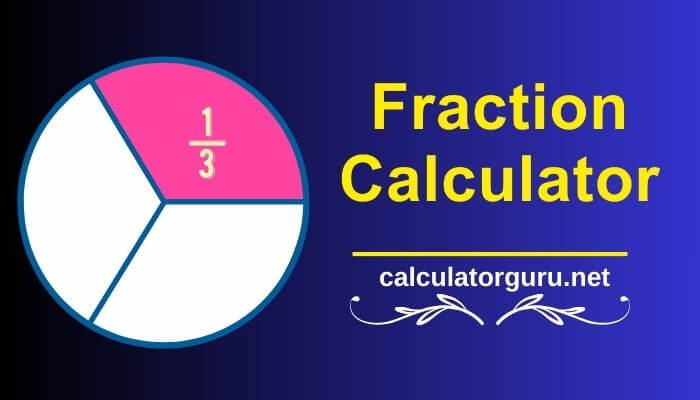Calculation Steps:
Mixed number calculator
|
|
|
Result:
Simplify Fraction Calculator
Result:
Fraction to decimal
Decimal to fraction
Result:
What are fractions?
Fractions are a fundamental part of mathematics that represent numbers that are not whole. They are a way of expressing a part of a whole or a part of a group. A fraction consists of two numbers separated by a line or slash: a numerator on top and a denominator on the bottom. The numerator indicates the part being considered, while the denominator represents the total number of equal parts that make up a whole.
Understanding the Basics:
Types of Fractions:
- Proper Fractions: These fractions have a numerator (top number) smaller than the denominator (bottom number), representing a value less than one, such as 3/4 or 5/8.
- Improper Fractions: Here, the numerator is equal to or greater than the denominator, representing a value equal to or greater than one, like 7/4 or 10/3.
- Mixed Numbers: These are a combination of a whole number and a fraction, like 2 1/3 or 5 2/5.
Parts of a Fraction:
- Numerator: The top number in a fraction, which represents the specific part of the whole.
- Denominator: The bottom number in a fraction, indicating the total number of equal parts in the whole.
How Fractions Work:
Representing Parts:
Fractions are used to divide an object or a quantity into equal parts. For example, if you divide a pizza into eight equal slices and you have three of them, you’d represent it as 3/8, indicating three out of the total eight slices.
Fraction Arithmetic:
Fractions can be added, subtracted, multiplied, and divided just like whole numbers. When adding or subtracting fractions, the denominators must be the same. Multiplication involves multiplying the numerators together and denominators together. The division is performed by multiplying by the reciprocal of the second fraction.
Introducing our fraction calculator:
Fractions are a way of showing parts of a whole. Think of them as slices of pizza or segments of a chocolate bar. They consist of a numerator (the number on top) and a denominator (the number on the bottom). For example, ½ represents one part of two equal parts. But working with fractions doesn’t have to be daunting. Let’s dive into using a fraction calculator to make this math task much easier.

Our fraction calculator is a powerful tool that simplifies working with fractions. It comes equipped with several handy features designed to assist you in various mathematical operations.
1. Fraction Calculator: Adding, Subtracting, Multiplying, and Dividing Fractions
Whether it’s combining parts, taking away portions, finding shared amounts, or splitting things up, this feature helps perform these operations effortlessly. All you need to do is enter the fractions, and the calculator does the hard work for you.
2. Mixed Number Calculator: Handling Whole Numbers with Fractions
Sometimes, you’ll come across numbers like 2 ½, where there’s a whole number alongside a fraction. This calculator handles such mixed numbers, making calculations involving them a breeze.
3. Simplified Fraction Calculator: Making Fractions Easier to Work With
Instead of dealing with complex fractions, this tool simplifies them for you. For instance, it’ll show ½ instead of 4/8, making calculations simpler and more understandable.
4. Fraction to Decimal and Decimal to Fraction Conversion
At times, you might need to switch between fractions and decimals. This calculator helps with those conversions, ensuring you can work comfortably with either format.
Step-by-Step Guide: Using the Fraction Calculator
Utilizing the fraction calculator is straightforward. Follow these simple steps to navigate its various functions:
Step 1: Select Your Operation
Begin by choosing what you want to do – add, subtract, multiply, or divide fractions.
Step 2: Enter Your Numbers
Type in your fractions or mixed numbers into the provided spaces, ensuring you input the numerator and denominator correctly.
Step 3: Hit Calculate
Once you’ve entered the numbers, click the ‘Calculate’ button, and your answer will appear promptly.
Tips for Efficient Calculation
Understanding fractions better involves mastering some key strategies. Here are a few tips to help you maneuver through fraction calculations smoothly:
1. Simplify, Simplify, Simplify
Always simplify fractions whenever possible. The simplified form is easier to handle and work with.
2. Convert When Necessary
If your teacher or task requires, use the conversion tools to switch between decimals and fractions.
Embrace Practice for Proficiency
Practice is key to mastering fractions. The more you practice using the fraction calculator, the more comfortable and adept you’ll become. Don’t be discouraged if it feels challenging initially – practice makes perfect!
Final Thoughts: Embracing the Power of the Fraction Calculator
Fractions might seem hard at first, but with our fraction calculator, you’ll feel much better about them. This tool helps you do simple math with fractions, deal with mixed numbers, make fractions simpler, and even switch between different types of numbers.
Just remember, that the more you practice, the better you’ll become at handling fractions. So, give the calculator a try, and you’ll soon feel like a math superstar!
Enjoy calculating!
